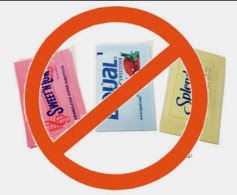10 years ago, if you said the word 'gluten', very few people would have a clue what you were talking about. Unless you had celiac or knew someone with celiac, gluten was a foreign word. Then when people started going to nutritionists and gastro doctors complaining of stomach pains, it was uncovered that gluten allergies and sensitivities were a thing. Doctors attributed any and all reactions to food as being gluten-based. The problem with this, is people were still getting sick when they weren't eating gluten. I finally (after dealing with this for years) found ONE nutritionist who suggested it could be coming from soy, and sure enough, the problem was solved (or so I thought). What I didn't realize when cutting out the easy to discover foods like soy sauce, is that soy lecithin, although not actually soy, needed to be cut too.
There were a few problems with this. Soy lecithin is in EVERYTHING. Go ahead, go to your kitchen and pick up pretty much any packaged food product. Chances are there's soy lecithin in it. Especially chocolate and salad dressings. If it's not soy lecithin, it's soybean oil, or soy flour. Soy has started to dominate the packaged food industry. It doesn't stop there though. When I went to Jacques Torres, I looked at every package in their store, and even though it's a fancy French chocolatier, still there was soy lecithin in everything.
Why is soy lecithin bad for you? What IS soy lecithin you ask? Let's uncover that now, shall we?
Soy lecithin is a food additive, used as an emulsifier to lengthen the shelf life of packaged food. Lecithin is a mixture of phospholipids and oil. To make soy lecithin, soybean oil is extracted from raw soybeans using a chemical solvent. Then the crude soy oil goes through a degumming process, where water is mixed until the lecithin separates from the oil. It's then dried and sometimes bleached with hydrogen peroxide. Aside from hydrogen peroxide, there's residue from chemicals at other stops along the way. While the lecithin is being removed, there's hexane in the oil that doesn't fully go away. The FDA doesn't regulate the amount of hexane residue in food products. What is hexane you ask? I don't know. But it's a chemical and so you shouldn't be eating it!!
Now most of the time soy lecithin makes up around 1% of the contents in the food, so it might not give you a hard time at all. But if it's in all the foods you're eating, it's better to avoid it altogether because it does add up. There are a lot of options for soy-free foods. With chocolate, more and more are being made sans soy lecithin. If it's 85% dark chocolate, it most likely won't have soy. Some of the cheaper brands still do use it, so unfortunately, aim for the more expensive ones. For anyone who knows me, this is not a comment that frequently comes out of my mouth. But I'd rather spend a little more and know there's no chemicals in my food and I won't feel sick after.
My new MO is not getting frustrated over the foods I can't eat, but finding alternative options to things I can. Will I sometimes cave and have some Rolos and M&Ms? Yes, everyone has a moment of weakness. The sugar issue complicates this further, because in the gluten-free, soy-free chocolate I've found, the sugar content ended up being high. So you have to pretty much make chocolate a special occasion type thing, to try to keep your soy away and sugar in check. Here's a list of my go-tos - if you know of other brands, let me know and I'll add them in!
Chocolate:
Theo
Enjoy Life
Sweet Riot
Trader Joe's belgian chocolate bars
Raaka
Equal Exchange
Hu
Theo
Enjoy Life
Sweet Riot
Trader Joe's belgian chocolate bars
Raaka
Equal Exchange
Hu
Bars:
Larabar
Pure organic
Zing
InBalance
Health Warrior Chia
Again, some regular brands that are 85% dark chocolate and higher don't contain soy lecithin. You have to check everything in the store before you buy it; because soy lecithin really will be in almost all chocolate you buy. I've found that there are a lot of small local brands in organic stores that seem to be safe. I know I mentioned this in my sugar post, but InBalance bars are great because they're soy free and low in sugar. The safe brands tend to use sunflower lecithin as a binding ingredient instead. I've also started making my own snacks, to avoid soy and make them natural. If you're interested, follow my paleo recipe boards:
http://www.pinterest.com/caspaqutie/paleo-recipes-success/
I've been collecting recipes for cookies, muffins, fudge and smoothies to fulfill my sweet tooth in the safest way possible. This soy sensitivity business can be extremely overwhelming, and my situation actually helped uncover that my friend had a severe allergy, and we figured it out together and now she's on the road to recovery. If you want to talk off-line about it, reach out! Caryn and I are in the process of working on taking courses to get certified to be legit nutritionists (on the side. I'm not leaving MMF/UA anytime soon!), but we do know a lot to help people figure out what's going on inside. And we're cheaper than real nutritionists too, since we're free :)















